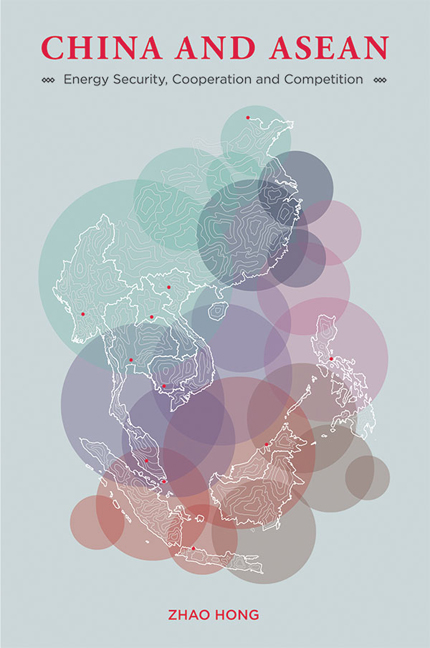Book contents
- Frontmatter
- Contents
- List of Tables and Figures
- List of Abbreviations
- Acknowledgements
- 1 Introduction: China, ASEAN, and the New Global Energy Order
- 2 Economic Growth and Energy Security
- 3 China's Energy Quest in Southeast Asia
- 4 Case Study (1): Myanmar
- 5 Case Study (2): Indonesia
- 6 Energy Resource Competition and the South China Sea Disputes
- 7 Conclusion
- Index
- About the Author
3 - China's Energy Quest in Southeast Asia
Published online by Cambridge University Press: 19 May 2017
- Frontmatter
- Contents
- List of Tables and Figures
- List of Abbreviations
- Acknowledgements
- 1 Introduction: China, ASEAN, and the New Global Energy Order
- 2 Economic Growth and Energy Security
- 3 China's Energy Quest in Southeast Asia
- 4 Case Study (1): Myanmar
- 5 Case Study (2): Indonesia
- 6 Energy Resource Competition and the South China Sea Disputes
- 7 Conclusion
- Index
- About the Author
Summary
Southeast Asia lies at the junction of South Asia and East Asia, and is traditionally seen by the United States, China, Japan, India, and other big powers as their respective spheres of influence. China has been a keen player in this region for historical reasons in view of the existence of a large diaspora, energy resource supply, trade and investment linkages and protection of its maritime interests. Energy resource cooperation is an important part of China–ASEAN relations. It has been driven under the background of China's energy diversification strategy, the development of China–ASEAN FTA (Free Trade Agreement) and regional economic integration. As China expanded its foreign direct investment (FDI) to Southeast Asia after the global financial crisis in 2008, cooperation in this field developed to a new level, extending from energy trade to energy resource exploration and related infrastructure-building.
CHINA'S ENERGY DIVERSIFICATION STRATEGY
China imports much of its oil from the Persian Gulf region through the Strait of Hormuz, where security is dependent on the U.S. Navy. The most prominent issues in the Middle East include the threat posed by Iran's nuclear programme, the emergence of the Islamic State of Iraq and Syria (ISIS) as a destabilizing force in Syria and Iraq, continued instability in North Africa, and the acceleration of Israeli–Palestinian conflicts. These are conflicts involving a great percentage of the world's major energy suppliers. Beijing is concerned about the implications of a potential reduction of U.S. presence in this region. Therefore Chinese leaders are facing questions about what they can and should do to protect the security of energy supply.
China's Approaches to Energy Resource Security
“Mercantilist” or “Liberalist” Approaches?
In a globalized economy, securing the supply of energy resources is a pressing issue for many states. All countries rely on energy to power their electricity and transportation systems, and the emerging economies require mineral resources for their rising industrial sectors. But energy resource production and consumption centres are often located in different national spaces. For emerging economies like China and India that lack local reserves of energy resources, this poses a particular challenge for their energy security. The need to import natural resources exposes these economies to high levels of resource insecurity, and many governments adopt energy resource security strategies to mitigate these risks.
- Type
- Chapter
- Information
- China and ASEANEnergy Security, Cooperation and Competition, pp. 77 - 111Publisher: ISEAS–Yusof Ishak InstitutePrint publication year: 2015



